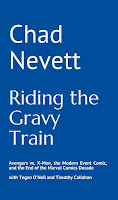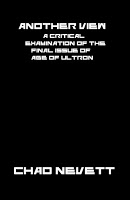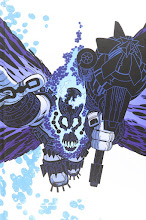The year is now 2002 and, if we're to believe the cover of Infinity Abyss #1, DOOMSDAY IS HERE! And, judging from the first page of the comic, I believe it. We've got An older, balder Adam Warlock bleeding, looking pretty fucking out of it and he narrates that he welcomes the "approaching doom." Jim Starlin is back doing what Starlin does best, people.
Not only is this Starlin doing what he will, he does the art as well, making it a true return to form as the last time he wrote and drew these characters was back in
I have no idea what happened to Warlock, Gamorra, Pip and Thanos since the end of The Infinity Watch and I don't care, because, well, let's be honest, Starlin wasn't on the keyboards. I'm a bit of a purist with certain characters and despite the fact that all of these characters are Marvel characters, not Starlin characters, anyone other than Starlin handling them seems... not wrong, but not canon.
This series is actually quite clever as it plants the seeds for the next series, Marvel: The End right in the first page as Thanos is tracking some big energy source before being attacked by someone.
Adam Warlock is in a mental assylum, back in his cacoon and getting picked up by Pip.
Gamorra encounters followers of Thanos, all nihilists and devoted to Death--except this Thanos looks like a robot.
And the Thanos that kidnapped Moondragon to help awaken Adam Warlock just changed shape into a smaller, big-headed version of Thanos called X that's hanging out with a hulking Thanos that has Gladiator's symbol on his chest called Warrior, and a Dr. Strange-like one called Mystic. The robot-looking one is called Armour (and spelled with the U all proper-like). Now, I love me some Thanos clones, so...
Apparently, Thanos experimented with genetic splicing and created some clones that are part him, part other people (Xavier, Gladiator, Strange and Iron Man in the case of the above--although, I do wonder how Tony Stark's DNA would cause a robot-like, armoured clone, but that's me). They're going to end the universe, having not progressed beyond Thanos' old obsession with Death.
Starlin is up to his old tricks by bringing Dr. Strange and the other Defenders into the plot along with Spider-Man and Captain Marvel--mostly because these characters don't do much actually. Although, they do contribute more to the eventual soluation than the heroes used to. Mostly, they protect a little girl who is destined to be the next being that makes sure the universe continues to survive (or something like that). The goal of Team Thanos is to make sure she dies since the old guardian guy is dying and when he dies, the universe dies and nihilists love that shit apparently.
The heroes eventually stop the Thanos clones and Adam and Gamorra stay with the little girl until she becomes accustomed to her new role, creating a nice little family unit (finally Gamorra gets her man). But, there's still one Thanos clone left, the one called Omega...
Half Thanos, half Galactus.
Yeah. How fucking awesome is that?
Most of the last issue of the story is devoted to the group of heroes killing Omega as it is more powerful than Galactus and totally devoted to destroying the universe. They do eventually kill it--by destroying its ship, temporarily blinding it and then using a fleet of ships to blow up the planet it's on, which also happens to be mined all to fuck. God bless Thanos.
The story ends with Thanos back at his unknown energy source and leads right into Marvel: The End, but that's next time.
This series really is a return for Starlin, especially since he does the art as well (with Al Milgrom on inks). Warlock is put through the mental ringer per usual, including one scene at the end of issue five where he uses the Soul Gem to absorb the soul of Warrior in order to save the almost-dead-cosmic-guy-who-keeps-the-universe alive... and then promptly tell us, "WARRIOR'S DREAMS OF OBLIVION... / THEY ARE NOW MY DREAMS." Oops. This is after he agrees to help the cosmic guy and that nearly drives him insane. Thankfully, Starlin is kind to the character and has him find some peace and love with Gamorra.
Starlin's use of Thanos here is very well-done as he manages to give us every facet of Thanos in one series without Thanos himself having to represent it all at once. His former nihilist character? His clones. His semi-evil, mad scientist character? The existence of the clones. The new, semi-heroic Thanos? The one that saves the universe. It also reminds the reader how powerful Thanos is, while at the same time, showing that pure power isn't what makes him so dangerous. You would think a group of clones that combine Thanos with the likes of Professor X, Gladiator, Dr. Strange, Iron Man and Galactus could destroy the universe since Thanos alone nearly did it many times, but, in a way, there's a suggestion that combining Thanos with those others actually dilutes the threat. Yes, in raw power, they have much, MUCH more, but they lack Thanos' will, his intellect, his drive... his soul, if you will. Thanos is so fucking dangerous because of who he is, not what he is.
You also get a sense of the tragic nature of Thanos, that he could be a real force for good and improving the universe, but he's built up so much bad-will and hatred that he can only stick to himself unless absolutely needed. He's the guy that they hate to call upon, but know they have to. He should, at this point, be much more of a hero, but because of his own guilt and desires, and the mistrust of others, he's off analysing some powerful energy that will end up--well, the next series is called Marvel: The End.
On Wednesday, Thanos destroys the universe in an effort to save the universe and make sure Joe Quesada's word is law. Really.






